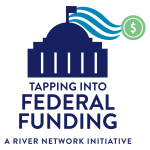What’s Inside the Infrastructure Investment and Jobs Act for Water?
Understanding what’s inside a 1,000+ page bill can feel daunting- so we’ve done our best to pull out the details below in a longer-than-usual blog post (!) as well as some thoughts on what’s ahead for implementing River Network’s priorities- clean, safe, affordable drinking water, resilient cities and communities, healthy rivers in agricultural landscapes, and robust and effective water laws and policies- are all present in the historic Infrastructure Investment and Jobs Act (HR 3684). The House of Representatives passed the bipartisan Act on November 6 in a 228-206 vote, with President Biden signing it on November 15. The legislation includes expansive investments in infrastructure- from roads, bridges, broadband internet, and railways to clean drinking water. $555 billion of the $1.2 trillion dollar deal is new spending.
How Much for Water Infrastructure?
Over the next five years, we’ll see $55 billion for water infrastructure improvements. $48.4 billion will come through the U.S. EPA for drinking water and wastewater.
Some highlights of where this money will flow include the following:
- $15 billion for lead service line replacement projects via Drinking Water State Revolving Fund (DWSRF).
- $3B for each fiscal year 2022-2026.
- 49% of the funds made available through DWSRF capitalization grants will be used to provide subsidies to eligible recipients with 100% forgiveness of principal or grants (i.e., they don’t have to be repaid). These funds are not subject to the usual DWSRF matching or cost sharing requirements. It’s not yet clear if grants will be prioritized to disadvantaged communities.
- $11.7 billion each for Drinking Water and Clean Water SRFs.
- Fund drinking water and wastewater treatment upgrades, storm water management, and more. Also requires states to award 49% of funds as grants or full principal forgiveness loans to eligible participants.
- $4 billion to address emerging contaminants in drinking water, with a focus on PFAS, through DWSRF capitalization grants or 100% principal forgiveness loans. The funds are not subject to match or cost share requirements.
- $1 billion to address PFAS through capitalization grants or 100% principal forgiveness loans in the Clean Water SRF. The funds are not subject to match or cost share requirements.
- $5 billion for grants to address emerging contaminants in small, underserved, and disadvantaged communities.
- These funds are not subject to matching or cost share requirements.
- $1 billion in additional funding for the Great Lakes Restoration Initiative for fiscal years 2022 through 2026. GLRI targets resources to address threats to the Great Lakes ecosystem. Read more from the Healing Our Waters (HOW) Great Lakes Coalition’s press release.
Other regional waters, including Chesapeake Bay, the Puget Sound, and the Gulf of Mexico received additional funding, totaling an additional $717 million:
-
- $238,000,000 Chesapeake Bay;
- $24,000,000 San Francisco Bay;
- $89,000,000 Puget Sound;
- $106,000,000 Long Island Sound;
- $53,000,000 Gulf of Mexico;
- $16,000,000 South Florida;
- $40,000,000 Lake Champlain;
- $53,000,000 Lake Pontchartrain;
- $15,000,000 Southern New England Estuaries;
- $79,000,000 Columbia River Basin; and
- $4,000,000 shall be for other geographic activities which includes Pacific Northwest.
- $132 million for the National Estuary Program to restore vulnerable coastal areas and communities.
- $60 million for the Gulf of Mexico Hypoxia Task Force.
- $250 million over five years to Indian reservation drinking water program to fund projects that improve water quality, water pressure, or water services through connecting, expanding, repairing, improving, or obtaining water from a public water system or to improve sanitation or wastewater services at treatment plants. Prioritizes projects responding to emergency situations due to a lack of access to clean drinking water.
Western Water Infrastructure
The bill included funding specifically for western water-related projects including water storage and transport, dam safety, water recycling, drought planning, desalination research and projects, and rural water projects through the Bureau of Reclamation. Specifics include:
- $1.150 billion for water storage, groundwater storage, and conveyance projects- including $100 million in grants for small storage projects.
- $3.2 billion for the Aging Infrastructure Account, of which $100 million is dedicated to rehabilitate, reconstruct, or replace dams.
- $1 billion for rural water projects authorized by Congress prior to July 1, 2021.
- $1 billion for water recycling and reuse programs.
- $250 million for water desalination projects and studies.
Additionally, a Water Reuse Interagency Working Group will be established to develop and coordinate actions, tools, and resources to advance water reuse, consisting of senior representatives from Federal agencies.
- $500 million appropriated to the Secretary of the Interior for the safety of dams program.
- $400 million for WaterSMART grants.
- $300 million to implement the Colorado River Basin Drought Contingency Plan to reduce risks from increasing drought and to protect the water resources of the Colorado River.
- $50 million of this amount will be used in accordance with the Drought Contingency Plan for the Upper Colorado River Basin.
- $100 million to provide financial assistance for watershed management projects.
- $250 million for design, study, and construction of aquatic ecosystem restoration and protection projects.
- $100 million for multi-benefit projects to improve watershed health. A competitive grant program will be established for eligible applicants, including States, Tribal or local government, water or power delivery authority organizations, regional authorities, or nonprofit conservation organizations.
- $50 million for endangered species recovery and conservation programs in the Colorado River Basin.
Dam Retrofitting and Removal
- In addition to the $500 million noted in the Western Water Infrastructure section for the safety of dams program, other funds have been made available to support the removal, rehabilitation, and retrofit of dams. Tribal communities will have access to $200 million to invest in the safety of dams, water sanitation, and other facilities. The Army Corps of Engineers will have $75 million for safety projects to maintain, upgrade, and repair dams listed in the National Inventory of Dams with a state, local government, public utility, or private owner. $733 million of Federal Assistance will be available as grants to states- a minimum of $75 million must be for the removal of dams. $10 million for capital improvement and maintenance is allotted toward the removal of non-hydropower Federal dams and for providing dam removal technical assistance.
Clean Water Infrastructure Resiliency and Sustainability Program
The program will award grants to increase the resilience of publicly owned treatment works to natural hazard and/or cybersecurity vulnerabilities through EPA. Grantees may use the funds to plan, design, or construct projects on a system-wide or area-wide basis to increase water conservation, increase water use efficiency, increase watershed preservation and protection, improve existing systems at risk of impairment or damage by natural disasters, or to increase energy efficiency.
- Authorizes appropriations of $25,000,000 each for fiscal years 2022-2026 ($125 million over five years). Grants shall not exceed 75% of the total cost of the proposed project except under certain criteria, where 90 to 100% may be covered.
Affordability and Access
The Administrator of the EPA (or a designated Federal agency) will conduct a needs assessment for nationwide rural and urban low-income community water assistance.
The study, which will be submitted as a report to Congress, will examine the prevalence of households who use a disproportionate amount of their income on access to drinking water or wastewater services across rural, medium, and large water service providers. The report will define “affordable access to water services” and the methodology and criteria used to determine the prevalence of a lack of affordable access to water services.
A Rural and Low-Income Water Assistance Pilot Program will be established to award grants to assist qualifying households to maintain access to drinking and waste water treatment in the next two years.
- Not yet funded. Will have to wait for subsequent appropriations legislation.
Indian Water Rights and Indian Health Service
- $2.5 billion for an Indian Water Rights Settlement Completion Fund,
- Established in the Treasury of the United States, for use by the Secretary of the Interior to transfer funds for Indian water settlements approved and authorized by an Act of Congress prior to enactment of this Act. As an example, this means the Navajo Utah Water Rights Settlement Act will be eligible. You can read more here.
- $3.5 billion dedicated to Indian Health Facilities for the provision of domestic and community sanitation facilities.
What’s Ahead for Implementation
The passage of the Infrastructure Investment and Jobs Act was monumental, and now the work of implementation begins. New and existing projects and programs across the country will need staff capacity, equitable metrics of success, and prudent planning to achieve the largest infrastructure investment in the country in the past five decades.
In a call with US EPA’s Office of Water to discuss the BIF, community organizations and advocates were urged to provide feedback to EPA to help them understand what barriers exist to access these new funding resources. Upcoming topic-specific meetings will be scheduled in the near future. In order for these funds to be transformational- especially in communities that historically have not accessed funds to their fullest potential- organizations and community leaders need to be communicating with state and local government on their plans to allocate funds to make sure projects end up on SRF priority lists.
What kind of projects are you hoping to see completed in your community from these funds? How will your state respond to this influx of water infrastructure investment? This is an historic moment- let’s keep the conversation going to support and learn from one another. Learn how to leverage State Revolving Funds through River Network’s Equitable Infrastructure Toolkit and be on the lookout for future peer calls.
Gaps Remain Ahead of Build Back Better (BBB) Vote: Lead Service Lines, Water Assistance
The Clean Water For All, Water Equity and Climate Resilience Caucus (WERC), Healing Our Waters – Great Lakes, and Choose Clean Water coalitions have all urged Congress to invest in water infrastructure beyond what was included in this bill. It’s likely that at least some additional investment will come to fruition once the Build Back Better Act passes.
It is estimated that $45 billion is needed to remove all lead service lines in the US – the BIF allocated $15 billion through DWSRFs. The BBB is slated to provide an additional $9 billion for lead service line replacement, filtration systems for schools, and lead remediation projects in disadvantaged communities. While this combined $24 billion of federal investment to get rid of lead will certainly help move the needle on how many lead pipes remain in our communities, gaps remain. Maureen Cunningham of EPIC outlined a compelling framework to use this funding with strong policies, which you can read here.
As the emergency Low-Income Household Water Assistance Program (LIHWAP) administered by Department of Health and Human Services slowly rolls out across the states, hopes of a robust and effective national water assistance program remain to be seen. The BIF created but did not fund a pilot program for rural and low-income households and calls for a needs assessment by the EPA. The BBB will establish and fund a water assistance program administered by the EPA- but the $250 million appropriated for fiscal year 2022 dims in comparison to the great need for debt relief- over $1 billion in water and wastewater debt accrued in California alone during the pandemic.







[…] passage of the Infrastructure Investment and Jobs Act (IIJA) last fall – or what is now known as the Bipartisan Infrastructure Law (BIL) – has been […]
[…] program established through the Infrastructure Investment and Jobs Act (IIJA), the Rural and Low-Income Water Assistance Pilot Program, holds potential as an opportunity […]
[…] kinds of funding are available? The BIL (also commonly referred to as the Infrastructure Investment and Jobs Act or IIJA) aims to increase […]